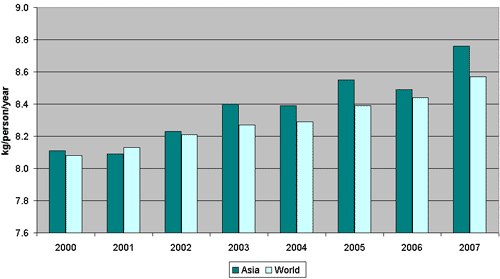



GLOBAL POULTRY TRENDS - Egg Consumption in Asia Grows Faster Than World Average
Annual per-capita chicken egg consumption in Asia is estimated to have risen to 9.2kg in 2010, writes Terry Evans in his analysis of egg consumption trends exclusively for ThePoultySite.Based on estimates of available supplies the FAO's calculations of egg consumption per person per year (table 1 and figure 1) indicate that egg uptake improved pretty well everywhere between 2000 and 2007 as the global average climbed from 8.1kg to almost 8.6kg per person.
Interestingly, the calculations for Asia reveal that, while the average consumption during 2000 and 2002 was virtually in line with the global figure. However, since then, consumption in Asia seems to have grown at a faster pace than the world average, such that by 2007, it had reached a record of nearly 8.8kg per person. Because we do not have data on trade since 2007, the estimates have been made of average consumption from 2008 to 2010 are not directly comparable with the figures presented in table 1. However, they indicate that average uptake has continued to rise both in Asia and globally to around 9.2kg per person for 2010.
It is clear that there are vast differences in the levels of consumption throughout Asia, the range being from as little as 1kg per person or less to a 'high' of 21kg. However, even small changes in the average uptake per person can represent a substantial quantity of eggs in those countries with a large human population.
Another area where the differences in consumption levels are great is in the uptake of eggs in product form.
Data from the International Egg Commission gives a good indication of this. The IEC figures are presented on the number of eggs eaten per person rather than on a weight basis. For 2009, the figures show that in some Asian countries like India the uptake per person in product form is virtually nil, while in others, it can range from as little as three eggs per person in Turkey and five in Iran, up to a massive 170 eggs per person in Japan.

It must be stressed that consumption data should not be taken too literally. As consumption is not measured directly, the figures are derived from other calculations, most of which incur significant margins of error. The measurement of the number of layers in a country can be imprecise, as can the assessment of how many eggs are laid per bird. Production figures can include hatching eggs. Also, while the percentages differ from country to country, in some instances a relatively large proportion of output comes from non-commercial or backyard flocks that are poorly monitored.
Furthermore, because of the fragile nature of eggs, considerable losses can be incurred during transit from the farm to the home or catering establishment. And finally, in most instances, consumption is expressed as a quantity eaten per person, which not only involves an assessment of the average egg weight but also an estimate of the size of the human population. For all these reasons, any series of consumption data are best used as a guide to the trend in uptake rather than the absolute levels of the quantity eaten.
| - | You can view other articles in our series Global Poultry Trends by clicking here. |
January 2011









